The Impact of Subsidies on the Prevalence of Climate-Sensitive Residential Buildings in Malaysia
Abstract
1. Introduction
2. Materials and Methods
2.1. Model Components, Simulation and Green Building Proxy
2.2. Cost-Premium Reinforcing Loop and Residential Building Stocks
2.2.1. Residential Green Buildings and Subsidies in Malaysia
2.2.2. Cost Premiums and the Experience Curve
2.2.3. Willingness to Pay for CSB
2.2.4. Stock and Flow Model
2.3. Factors Driving Housing Demand in Malaysia
2.4. Factors Driving WTP for AC Ownership in Malaysia
2.5. Factors Driving AC Usage in Malaysia
2.6. Combined Model
2.7. Model Assumptions and Limitations
3. Results
3.1. Subsidies and WTP
3.2. Shrinking the Housing Gap
3.3. Climate Change and AC Usage
4. Discussion
4.1. Climate Change, Heat Impacts on Health and Residential Buildings
4.2. Subsidies and WTP
4.3. Affordable Housing and CSB in the Malaysian Context
4.4. AC Use, Behavioral Feedback Loops and CSB Design
5. Conclusions
Supplementary Materials
Acknowledgments
Author Contributions
Conflicts of Interest
Appendix A. Logistic Curves—WTP for CSB, Thermal Preference and AC Ownership
References
- Davis, L.W.; Gertler, P.J. Contribution of air conditioning adoption to future energy use under global warming. Proc. Natl. Acad. Sci. USA 2015, 112, 5962–5967. [Google Scholar] [CrossRef] [PubMed]
- Sailor, D.J.; Pavlova, A.A. Air conditioning market saturation and long-term response of residential cooling energy demand to climate change. Energy 2003, 28, 941–951. [Google Scholar] [CrossRef]
- Isaac, M.; van Vuuren, D.P. Modeling global residential sector energy demand for heating and air conditioning in the context of climate change. Energy Policy 2009, 37, 507–521. [Google Scholar] [CrossRef]
- Auffhammer, M.; Baylis, P.; Hausman, C.H. Climate change is projected to have severe impacts on the frequency and intensity of peak electricity demand across the United States. Proc. Natl. Acad. Sci. USA 2017, 114, 1886–1891. [Google Scholar] [CrossRef] [PubMed]
- Santagata, D.M.; Castesana, P.; Rossler, C.E.; Comez, D.R. Extreme temperature events affecting the electricity distribution system of the metropolitan area of Buenos Aires (1971–2013). Energy Policy 2017, 106, 404–414. [Google Scholar] [CrossRef]
- Australian Productivity Commission. Electricity Network Regulatory Frameworks; Report No. 62; Australian Productivity Commission: Canberra, Australia, 2013.
- Faivre, O.; Herve, Y.L.E.; Jehl, P.; Jouhanneau, S.; Bugnot, E. Forecast of faults during heat waves in a medium voltage grid and crisis management. In Proceedings of the CIRED Workshop, Helsinki, Finland, 14–15 June 2016. [Google Scholar]
- Steffen, W.; Hughes, L.; Perkins, S. Heatwaves: Longer, Hotter, More Often; Climate Council of Australia Limited: Sydney, Australia, 2014. [Google Scholar]
- Entriken, R.; Lordan, R. Impacts of Extreme Events on Transmission and Distribution Systems. In Proceedings of the 2012 IEEE Power Energy Society General Meeting, San Diego, CA, USA, 22–26 July 2012; pp. 1–10. [Google Scholar] [CrossRef]
- Salamanca, F.; Georgescu, M.; Mahalov, A.; Moustaoui, M.; Wang, M. Anthropogenic heating of the urban environment due to air conditioning. J. Geophys. Res. Atmos. 2014, 119, 5949–5965. [Google Scholar] [CrossRef]
- Munck, C.; Pigeon, G.; Masson, V.; Meunier, F.; Bousquet, P.; Tremeac, B.; Merchat, M.; Poeuf, P.; Marchadier, C. How much can air conditioning increase air temperatures for a city like Paris, France? Int. J. Climatol. 2013, 33, 210–227. [Google Scholar] [CrossRef]
- Salamanca, F.; Martilli, A.; Tewari, M.; Chen, F. A study of the urban boundary layer using different urban parameterizations and high-resolution urban canopy parameters with WRF. J. Am. Meterol. Soc. 2011, 50, 1107–1128. [Google Scholar] [CrossRef]
- Ohashi, Y.; Genshi, Y.; Kondo, H.; Kikegawa, Y.; Yoshikado, H.; Hirano, Y. Influence of air-conditioning waste heat on air temperature in Tokyo during summer: Numerical experiments using an urban canopy model coupled with a building energy model. J. Appl. Meteorol. Climatol. 2007, 46, 66–81. [Google Scholar] [CrossRef]
- Kikegawa, Y.; Genchi, Y.; Yoshikado, H.; Kondo, H. Development of a numerical simulation system toward comprehensive assessments of urban warming countermeasures including their impacts upon the urban buildings’ energy-demands. Appl. Energy 2003, 76, 449–466. [Google Scholar] [CrossRef]
- Hsieh, C.M.; Aramaki, T.; Hanaki, K. The feedback of heat rejection to air conditioning load during the nighttime in subtropical climate. Energy Build. 2007, 39, 1175–1182. [Google Scholar] [CrossRef]
- Wen, Y.; Lian, Z. Influence of air conditioners utilization on urban thermal environment. Appl. Therm. Eng. 2009, 29, 670–675. [Google Scholar] [CrossRef]
- Obradovich, N.; Migliorini, R.; Mednick, S.C.; Fowler, J.H. Nighttime temperature and human sleep loss in a changing climate. Sci. Adv. 2017, 3, e160155. [Google Scholar] [CrossRef] [PubMed]
- National Oceanic and Atmospheric Administration National Weather Service. Join the National Weather Service in Promoting Heat Awareness Day on May 30s; National Oceanic and Atmospheric Administration National Weather Service: Washington, DC, USA, 2012.
- Farbotko, C.; Waltt, G. Residential air-conditioning and climate change: Voices of the vulnerable. Health Promot. J. Aust. 2011, 22, S13–S16. [Google Scholar] [PubMed]
- De Magalhaes Rios, J.L.M.; Boechat, J.L.; Gioda, A.; dos Santos, C.Y.; de Aquino Neto, F.R.; Lapa e Silva, J.R.L. Symptoms prevalence among office workers of a sealed versus a non-sealed building: Associations to indoor air quality. Environ. Int. 2009, 35, 1136–1141. [Google Scholar] [CrossRef] [PubMed]
- Sahakian, N.; Park, J.H.; Cox-Ganser, J. Respiratory morbidity and medical visits associated with dampness and air-conditioning in offices and homes. Indoor Air 2009, 19, 58–67. [Google Scholar] [CrossRef] [PubMed]
- Graudenz, G.S.; Oliveira, C.H.; Tribess, A.; Mendes, C., Jr.; Latorre, M.R.D.O.; Kalil, J. Association of air-conditioning with respiratory symptoms in office workers in tropical climate. Indoor Air 2004, 15, 62–66. [Google Scholar] [CrossRef] [PubMed]
- Preziosi, P.; Czernichow, S.; Gehanno, P.; Hercberg, S. Workplace air-conditioning and health services attendance among French middle-aged women: A prospective cohort study. Int. J. Epidemiol. 2004, 33, 1120–1123. [Google Scholar] [CrossRef] [PubMed]
- Kubota, T.; Jeong, S.; Toe, D.H.C.; Ossen, D.R. Energy consumption and air-conditioning usage in residential buildings of Malaysia. J. Int. Dev. Coop. 2011, 17, 61–69. [Google Scholar] [CrossRef]
- Kubota, T.; Toe, D.H.C. Potential of passive cooling techniques for modern houses in the tropical climate of Malaysia—Analysis of the indoor thermal environment for various ventilation strategies. Int. J. Vent. 2010, 9, 11–23. [Google Scholar] [CrossRef]
- Hassan, J.S.; Zin, R.M.; Majid, M.Z.; Balubaid, S.; Hainin, M.R. Building energy consumption in Malaysia: An overview. J. Teknol. 2014, 70, 33–38. [Google Scholar] [CrossRef]
- Maller, C.J.; Strengers, Y. Housing, heat stress and health in a changing climate: Promoting the adaptive capacity of vulnerable households, a suggested way forward. Health Promot. Int. 2011, 26, 492–498. [Google Scholar] [CrossRef] [PubMed]
- Van der Heijden, J. On the potential of voluntary environmental programmes for the built environment: A critical analysis of LEED. J. Hous. Built Environ. 2015, 30, 553–567. [Google Scholar] [CrossRef]
- Hwang, B.G.; Tan, J.S. Green building project management: Obstacles and solutions for sustainable development. Sustain. Dev. 2010, 20, 335–349. [Google Scholar] [CrossRef]
- Issa, M.H.; Rankin, J.H.; Christian, A.J. Canadian practitioners’ perception of research work investigating the cost premiums, long-term costs and health and productivity benefits of green buildings. Build. Environ. 2010, 45, 1689–1711. [Google Scholar] [CrossRef]
- Alias, A.; Sin, T.K.; Aziz, W.N.A.W.A. The green home concept- acceptability and development problems. J. Build. Perform. 2010, 1, 130–139. [Google Scholar]
- Chan, E.H.W.; Qian, Q.K.; Lam, P.T.I. The market for green building in developed Asian cities—The perspectives of building designers. Energy Policy 2009, 37, 3061–3070. [Google Scholar] [CrossRef]
- Chan, A.P.C.; Darko, A.; Ameyaw, E.E. Strategies for promoting green building technologies adoption in the construction industry—An international study. Sustainability 2017, 9, 969. [Google Scholar] [CrossRef]
- Nalewaik, A.; Venters, V. Dev. 02: Costs and benefits of building green. AACE Int. Trans. 2008, 1–9. [Google Scholar]
- Green Building Index Executive Summary. Executive Summary as of 15 May 2017. Available online: http://new.greenbuildingindex.org/organisation/summary (accessed on 1 June 2017).
- Green Building Information Gateway. Malaysia Database. Available online: http://www.gbig.org/places/752 (accessed on 1 June 2017).
- Khazanah Research Institute. Economic Development in 2015; Khazanah Research Institute: Kuala Lumpur, Malaysia, 2016. [Google Scholar]
- Ministry of Finance Malaysia. The 2010 Budget; Ministry of Finance Malaysia, Percetakan Nasional Malaysia Berhad: Kuala Lumpur, Malaysia, 2009.
- Ministry of Finance Malaysia. The 2014 Budget; Ministry of Finance Malaysia, Percetakan Nasional Malaysia Berhad: Kuala Lumpur, Malaysia, 2013.
- Abidin, N.Z.; Yusof, N.A.; Othman, A.A.E. Enablers and challenges of a sustainable housing industry in Malaysia. Constr. Innov. 2013, 13, 10–25. [Google Scholar] [CrossRef]
- Dwaikat, L.N.; Ali, K.N. Green buildings cost premium: A review of empirical evidence. Energy Build. 2016, 110, 396–403. [Google Scholar] [CrossRef]
- Azizi, N.Z.M.; Abidin, N.Z.; Raofuddin, A. Identification of soft cost elements in green projects: Exploring experts’ experience. Procedia Soc. Behav. Sci. 2015, 170, 18–26. [Google Scholar] [CrossRef][Green Version]
- Qian, Q.K.; Chan, E.H.W.; Khalid, A.G. Challenges in delivering green building projects: Unearthing the transaction costs (TCs). Sustainability 2015, 7, 3615–3636. [Google Scholar] [CrossRef]
- Chegut, A.; Eichholtz, P.; Kok, N. The Price of Innovation: An Analysis of the Marginal Cost of Green Buildings. Center for Real Estate MIT Working Paper Series. 2015. Available online: http://www.corporate-engagement.com/research/133 (accessed on 30 November 2017).
- Aliagha, G.U.; Hashim, M.; Sanni, A.O.; Ali, K.N. Review of green building demand factors for Malaysia. Int. J. Energy Technol. Policy 2013, 3, 471–478. [Google Scholar]
- Morris, P.; Langdon, D. What does green really cost? PREA Q. Summer 2007, 55–60. [Google Scholar]
- Matthiessen, L.; Morris, P.; Langdon, D. Costing Green: A Comprehensive Cost Database and Budgeting Methodology; U.S. Green Building Council: Washington, DC, USA, 2004. [Google Scholar]
- Dodge Data & Analytics. Green and Healthier Homes: Engaging Consumers of All Ages in Sustainable Living; Dodge Data & Analytics: New York, NY, USA, 2015. [Google Scholar]
- CBRE Malaysia. CB Richard Ellis Malaysia Special Report: Going Green Malaysia; CBRE Malaysia: Kuala Lumpur, Malaysia, 2010. [Google Scholar]
- Kwan, H.H. QS practice notes & qualifying capex for non M&E Items. In Proceedings of the GBI Roadshow 2016, Kota Kinabalu, Sabah, 16 November 2016. [Google Scholar]
- Jakob, M.; Madlener, R. Riding down the experience curve for energy-efficient building envelopes: The Swiss case for 1970–2020. Int. J. Energy Technol. Policy 2004, 2, 153–178. [Google Scholar] [CrossRef]
- Sundaram, R. Applying Learning Curve Theory in Construction Cost Estimating. Available online: https://www.fgould.com/americas/articles/applying-learning-curve-theory-construction-cost/ (accessed on 30 May 2017).
- Yau, Y. Eco-labels and willingness-to-pay: A Hong Kong study. Smart Sustain. Built Environ. 2012, 1, 277–290. [Google Scholar] [CrossRef]
- Zhang, L.; Sun, C.; Liu, H.; Zheng, S. The role of public information in increasing homebuyers’ willingness-to-pay for green housing: Evidence from Beijing. Ecol. Econ. 2016, 129, 40–49. [Google Scholar] [CrossRef]
- Braganca, L.; Vieira, S.M.; Andrade, J.B. early stage design decisions: The way to achieve sustainable buildings at lower costs. Sci. World J. 2014, 365364. [Google Scholar] [CrossRef] [PubMed]
- Syphers, G.; Baum, M.; Bouton, D.; Sullens, W. Managing the Cost of Green Buildings; KEMA Xenergy: Oakland, CA, USA, 2003. [Google Scholar]
- Department of Statistics Malaysia eDataBank. Population Projection. Available online: https://www.dosm.gov.my/v1/index.php?r=column/cthree&menu_id=cEhBV0xzWll6WTRjdkJienhoR290QT09 (accessed on 31 May 2017).
- Khazanah Research Institute. Making Housing Affordable; Khazanah Research Institute: Kuala Lumpur, Malaysia, 2015. [Google Scholar]
- Department of Statistics Malaysia. Population Distribution and Basic Demographic Characteristics 2010; Department of Statistics Malaysia: Putrajaya, Malaysia, 2011.
- Department of Statistics Malaysia. Household Income and Basic Amenities Survey Report 2014; Department of Statistics Malaysia: Putrajaya, Malaysia, 2015.
- Department of Statistics Malaysia. Household Income and Basic Amenities Survey Report 2012; Department of Statistics Malaysia: Putrajaya, Malaysia, 2013.
- Department of Statistics Malaysia. Household Income and Basic Amenities Survey Report 2009; Department of Statistics Malaysia: Putrajaya, Malaysia, 2010.
- Department of Statistics Malaysia. Household Income and Basic Amenities Survey Report 2006; Department of Statistics Malaysia: Putrajaya, Malaysia, 2007.
- Department of Statistics Malaysia. Household Income and Basic Amenities Survey Report 2004; Department of Statistics Malaysia: Putrajaya, Malaysia, 2005.
- Department of Statistics Malaysia. Household Income and Basic Amenities Survey Report 2002; Department of Statistics Malaysia: Putrajaya, Malaysia, 2003.
- The World Bank Data Bank Country Profile Malaysia. Available online: https://data.worldbank.org/country/malaysia (accessed on 8 June 2017).
- Nolan, B.; Roser, M.; Thewissen, S. GDP Per Capita Versus Median Household Income: What Gives Rise to Divergence over Time? Institute for New Economic Thinking Oxford Working Paper no. 2016–03, 2016. Available online: http://www.lisdatacenter.org/wps/liswps/672.pdf (accessed on 30 November 2017).
- Pricewaterhouse Coopers World in 2050. Available online: https://www.pwc.com/gx/en/issues/economy/the-world-in-2050.html#data (accessed on 8 June 2017).
- Djamila, H.; Chu, C.M.; Kumaresan, S. Field study of thermal comfort in residential buildings in the equatorial hot-humid climate of Malaysia. Build. Environ. 2013, 62, 133–142. [Google Scholar] [CrossRef]
- Djamila, H.; Chu, C.M.; Kumaresan, S. Investigation on hourly and monthly thermal comfort in the humid tropics of Malaysia. Buildings 2015, 5, 1025–1036. [Google Scholar] [CrossRef]
- Humphreys, M.; Hancock, M. Do people like to feel ‘neutral’? Exploring the variation of the desired thermal sensation on the ASHRAE scale. Energy Build. 2007, 39, 867–874. [Google Scholar] [CrossRef]
- Feiradi, H.; Wong, N.H. Thermal comfort for naturally ventilated houses in Indonesia. Energy Build. 2004, 36, 614–626. [Google Scholar] [CrossRef]
- Feriadi, H.; Wong, N.H.; Chandra, S.; Cheong, W.K. Adaptive behaviour and thermal comfort in Singapore’s naturally ventilated housing. Build. Res. Inf. 2003, 31, 13–23. [Google Scholar] [CrossRef]
- Han, J.; Zhang, G.; Zhang, Q.; Zhang, J.; Liu, J.; Tian, L.; Zheng, C.; Hao, J.; Lin, J.; Liu, Y.; Moschandreas, D.J. Field study on occupants’ thermal comfort and residential thermal environment in a hot-humid climate of China. Build. Environ. 2007, 42, 4043–4050. [Google Scholar] [CrossRef]
- CCSM3 hourly temperature projections for Subang; National Hydraulic Research Institute Malaysia (NAHRIM): Seri Kembangan, Malaysia, 2017.
- Chen, W.; Hong, X. Design of effective subsidy policy to develop green buildings: From the perspective of policy benefit. Clean Technol. Environ. Policy 2015, 17, 1029–1038. [Google Scholar] [CrossRef]
- Chau, C.K.; Tse, M.S.; Chung, K.Y. A choice experiment to estimate the effect of green experience on preferences and willingness-to-pay for green building attributes. Build. Environ. 2010, 45, 2553–2561. [Google Scholar] [CrossRef]
- Salvi, M.; Syz, J. What drives “green housing” construction? Evidence from Switzerland. J. Financ. Econ. Policy 2011, 3, 86–102. [Google Scholar] [CrossRef]
- Gardner, B. A review and analysis of the use of ‘habit’ in understanding, predicting and influencing health related behaviour. Health Psychol. Rev. 2015, 9, 277–295. [Google Scholar] [CrossRef] [PubMed]
- Kor, K.; Mullan, B.A. Sleep hygiene behaviours: An application of the theory of planned behaviour and the investigation of perceived autonomy support, past behaviour and response inhibition. Psychol. Health 2011, 9, 1208–1224. [Google Scholar] [CrossRef] [PubMed]
- IPCC. Climate Change 2013 The Physical Science Basis: Contribution of Working Group I to the Fifth Assessment Report of the Intergovernmental Panel on Climate Change; Stocker, T.F., Qin, D., Plattner, G.K., Tignor, M., Allen, S.K., Boschung, J., Nauels, A., Xia, Y., Bex, V., Midgley, P.M., Eds.; Cambridge University Press: Cambridge, UK; New York, NY, USA, 2013. [Google Scholar]
- Adams, S.; Baarsch, F.; Bondeau, A.; Coumou, D.; Donner, R.; Frieler, K.; Hare, B.; Menon, A.; Perette, M.; Piontek, F.; et al. Turn Down the Heat: Climate Extremes, Regional Impacts, and the Case for Resilience; World Bank: Washington, DC, USA, 2013. [Google Scholar]
- Kenny, G.P.; Yardley, J.; Brown, C.; Sigal, R.J.; Jay, O. Heat stress in older individuals and patients with common chronic diseases. Can. Med. Assoc. J. 2010, 182, 1053–1060. [Google Scholar] [CrossRef] [PubMed]
- Semenza, J.C.; Rubin, C.H.; Falter, K.H.; Selanikio, J.D.; Flanders, W.D.; Howe, H.L.; Wilhelm, J.L. Heat-related deaths during the July 1995 heat wave in Chicago. N. Engl. J. Med. 1996, 335, 84–90. [Google Scholar] [CrossRef] [PubMed]
- Semenza, J.C.; McCullough, J.E.; Flanders, W.D.; McGeehin, M.A.; Lumpkin, J.R. Excess hospital admissions during the July 1995 heat wave in Chicago. Am. J. Prev. Med. 1999, 16, 269–277. [Google Scholar] [CrossRef]
- Havenith, G.; Coenen, J.M.; Kistemaker, L.; Kenney, W.L. Relevance of individual characteristics for human heat stress response is dependent on exercise intensity and climate type. Eur. J. Appl. Physiol. Occup. Physiol. 1998, 77, 231–241. [Google Scholar] [CrossRef] [PubMed]
- Bar-Or, O.; Lundegren, H.M.; Buskirk, E.R. Heat tolerance of exercising obese and lean women. J. Appl. Physiol. 1969, 26, 403–409. [Google Scholar] [PubMed]
- Sherwood, S.C.; Huber, M. An adaptability limit to climate change due to heat stress. Proc. Natl. Acad. Sci. USA 2010, 107, 9552–9555. [Google Scholar] [CrossRef] [PubMed]
- Mazdiyasni, O.; AghaKouchak, A.; Davis, S.J.; Madadgar, S.; Mehran, A.; Ragno, E.; Sadegh, M.; Sengupta, A.; Ghosh, S.; Dhanya, C.T.; et al. Increasing probability of mortality during Indian heat waves. Sci. Adv. 2017, 3, e1700066. [Google Scholar] [CrossRef] [PubMed]
- White-Newsome, J.L.; Sanchez, B.N.; Jolliet, O.; Zhang, Z.; Parker, E.A.; Dvonch, J.T.; O’Neill, M.S. Climate change and health: Indoor heat exposure in vulnerable populations. Environ. Res. 2012, 112, 20–27. [Google Scholar] [CrossRef] [PubMed]
- Vandentorren, S.; Bretin, P.; Zeghnoun, A.; Mandereau-Bruno, L.; Croisier, A.; Chochet, C.; Riberon, J.; Siberan, I.; Declercq, B.; Ledrans, M. August 2003 Heat wave in France: Risk factors for death of elderly people living at home. Eur. J. Public Health 2006, 15, 583–591. [Google Scholar] [CrossRef] [PubMed]
- Zhang, K.; Rood, R.B.; Michailidis, G.; Oswald, E.M.; Schwartz, J.D.; Zanobetti, A.; Ebi, K.L.; O’Neill, M.S. Comparing exposure metrics for classifying ‘dangerous heat’ in heat wave and health warning systems. Environ. Int. 2012, 46, 23–29. [Google Scholar] [CrossRef] [PubMed]
- Martiello, M.A.; Giacchi, M.V. High temperatures and health outcomes: A review of the literature. Scand. J. Public Health 2010, 38, 826–837. [Google Scholar] [CrossRef] [PubMed]
- Eisenman, D.P.; Wilhalme, H.; Tseng, C.; Chester, M.; English, P.; Pinceti, S.; Fraser, A.; Vangala, S.; Dhaliwal, S.K. Heat death associations with the built environment, social vulnerability and their interactions with rising temperature. Health Place 2016, 41, 89–99. [Google Scholar] [CrossRef] [PubMed]
- Weber, S.; Sadoff, N.; Zell, E.; de Sherbinin, A. Policy-relevant indicators for mapping the vulnerability of urban populations to extreme heat events: A case study of Philadelphia. Appl. Geogr. 2015, 63, 231–243. [Google Scholar] [CrossRef]
- Deschenes, O. Temperature, human health, and adaptation: A review of the empirical literature. Energy Econ. 2014, 46, 606–619. [Google Scholar] [CrossRef]
- United States Center for Disease Control and Prevention. Heat-related deaths after an extreme heat event—Four states, 2012, and United States, 1999–2009. Morb. Mortal. Wkly. Rep. 2013, 62, 433–436. [Google Scholar]
- Siri, J.G.; Newell, B.; Proust, K.; Capon, A. Urbanization, extreme events and health: The case for systems approaches in mitigation, management, and response. Asia Pac. J. Public Health 2016, 28, 15S–27S. [Google Scholar] [CrossRef] [PubMed]
- Dodge Data & Analytics. World Green Building Trends 2016; Dodge Data & Analytics: New York, NY, USA, 2016. [Google Scholar]
- Fuerst, F.; Kontokosta, C.; McAllister, P. Determinants of green building adoption. Environ. Plan. B Plan. Des. 2014, 41, 551–570. [Google Scholar] [CrossRef]
- Yau, Y.; Chiu, S.M.; Lau, W.K. Economising subsidies for green housing features: A stated preference approach. Urbani Izziv 2014, 25, 107–118. [Google Scholar] [CrossRef]
- Heinzle, S.L.; Boey, A.Y.Y.; Low, M.Y.X. The influence of green building certification schemes on real estate investor behaviour: Evidence from Singapore. Urban Stud. 2012, 50, 1970–1987. [Google Scholar] [CrossRef]
- Hu, H.; Greetman, S.; Hooimeijer, P. Personal values that drive the choice for green apartments in Nanjing China: The limited role of environmental values. J. Hous. Built Environ. 2016, 31, 659–675. [Google Scholar] [CrossRef]
- Fuerst, F.; Shimizu, C. Green luxury goods? The economics of eco-labels in the Japanese housing market. J. Jpn. Int. Econ. 2016, 39, 108–122. [Google Scholar] [CrossRef]
- Qiu, Y.; Tiwari, A.; Yang, Y.D. The diffusion of voluntary green building certification: A spatial approach. Energy Effic. 2015, 8, 449–471. [Google Scholar] [CrossRef]
- Qiu, Y.; Yin, S.; Wang, Y.D. Peer effects and voluntary green building certification. Sustainability 2016, 8, 632. [Google Scholar] [CrossRef]
- The Lantau Group. Global Benchmark Study of Residential Electricity Tariffs; The Lantau Group: Hong Kong, China, 2013. [Google Scholar]
- CBRE. Who Pays for Green? The Economics of Sustainable Buildings; CBRE: Los Angeles, CA, USA, 2009. [Google Scholar]
- Yunus, R.; Yang, J. Sustainability criteria for industrialised building systems (IBS) in Malaysia. Procedia Eng. 2011, 14, 1590–1598. [Google Scholar] [CrossRef]
- Marron, D. Greener public purchasing as an environmental policy instrument. OCED J. Budg. 2003, 3, 71–105. [Google Scholar] [CrossRef]
- Simcoe, T.; Toffel, M.W. Public Procurement and the Private Supply of Green Buildings; Working Paper 18385; National Bureau of Economic Research: Cambridge, MA, USA, 2012. [Google Scholar]
- Ministry of Finance Malaysia. The 2016 Budget; Ministry of Finance Malaysia, Percetakan Nasional Malaysia Berhad: Kuala Lumpur, Malaysia, 2013.
- Jaafar, M.F.Z. Adapting to technology: The case of air conditioning use in Malaysian homes. In Proceedings of the Adapting to Change: New Thinking on Comfort Cumberland Lodge, Windsor, UK, 9–11 April 2010. [Google Scholar]
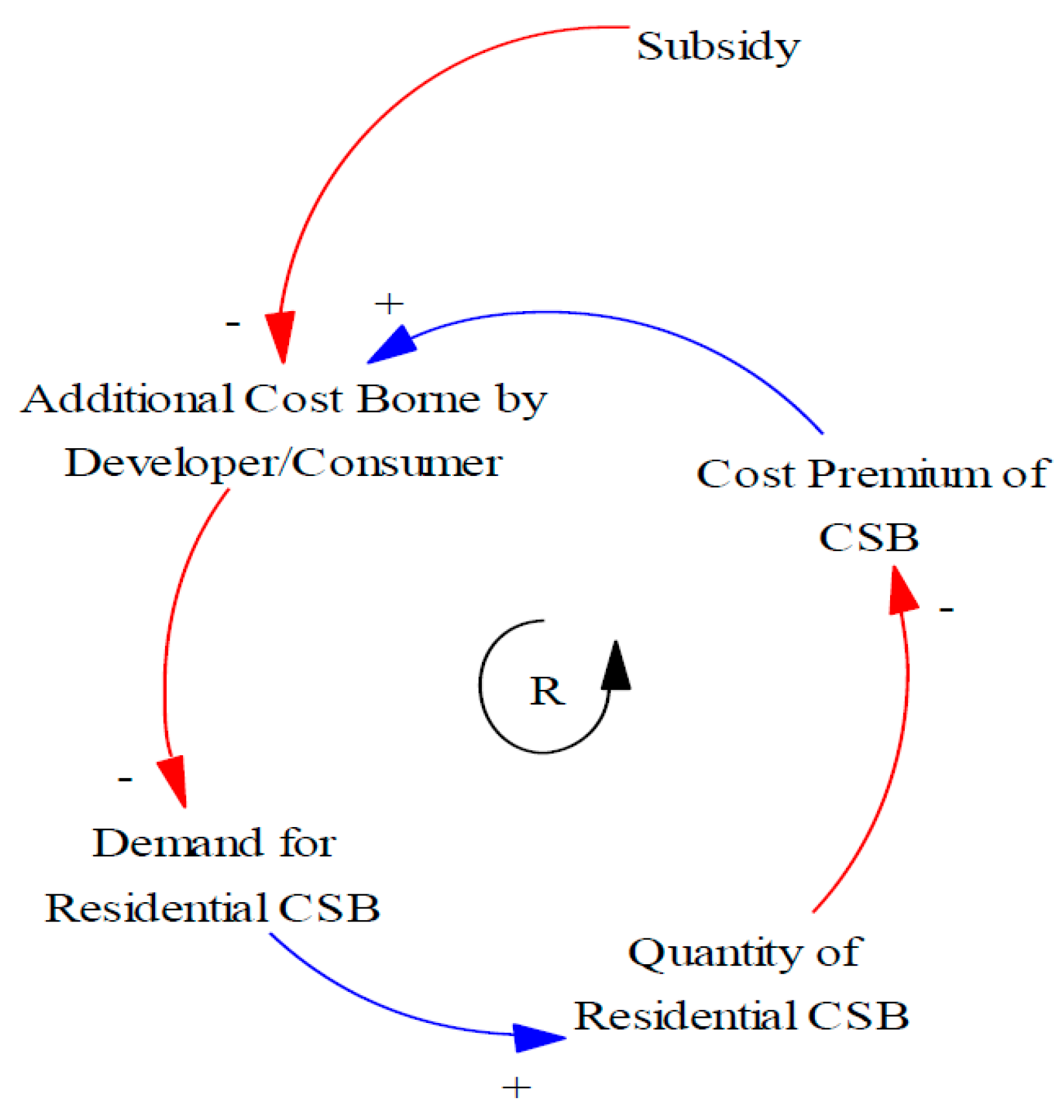
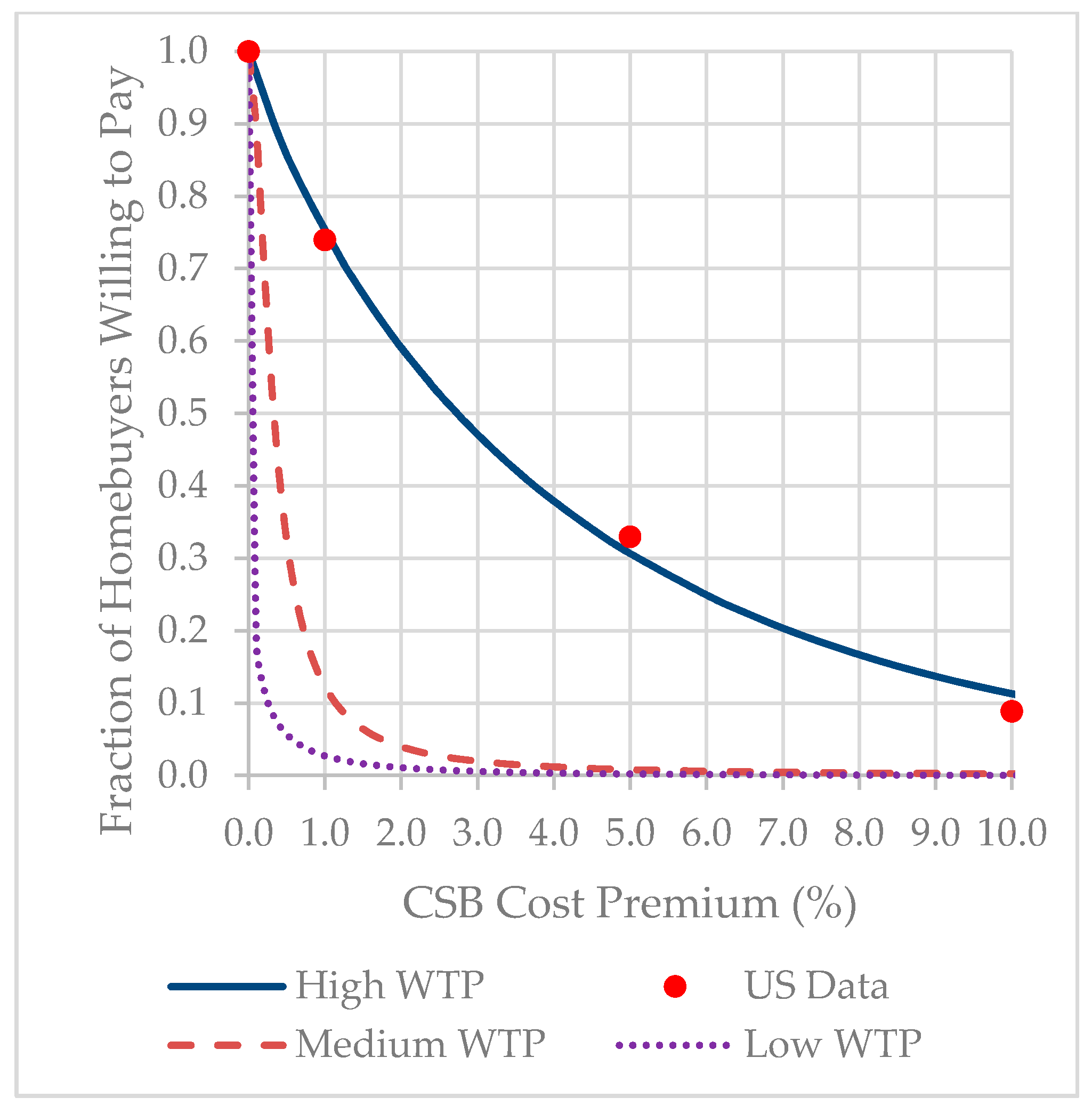
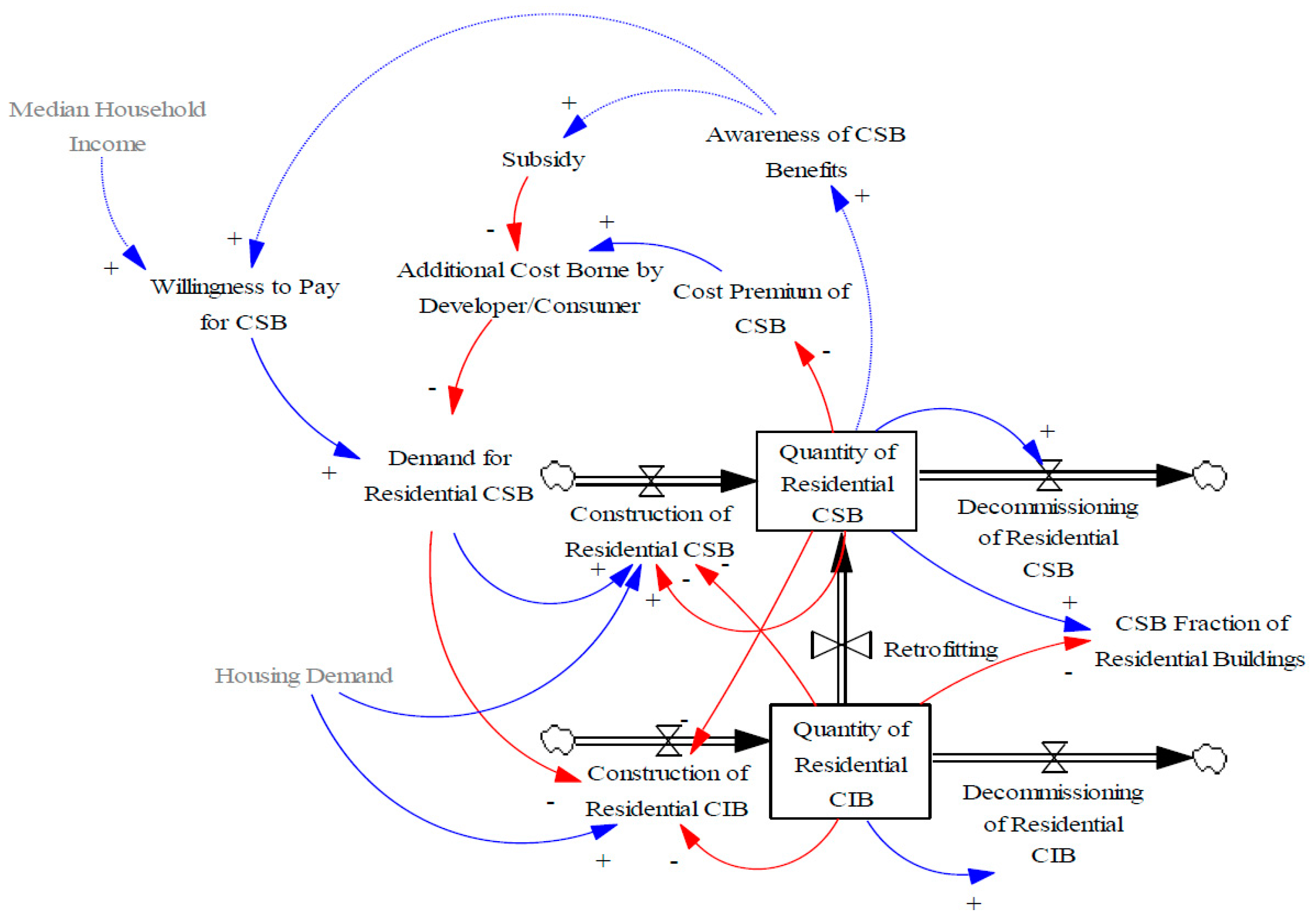
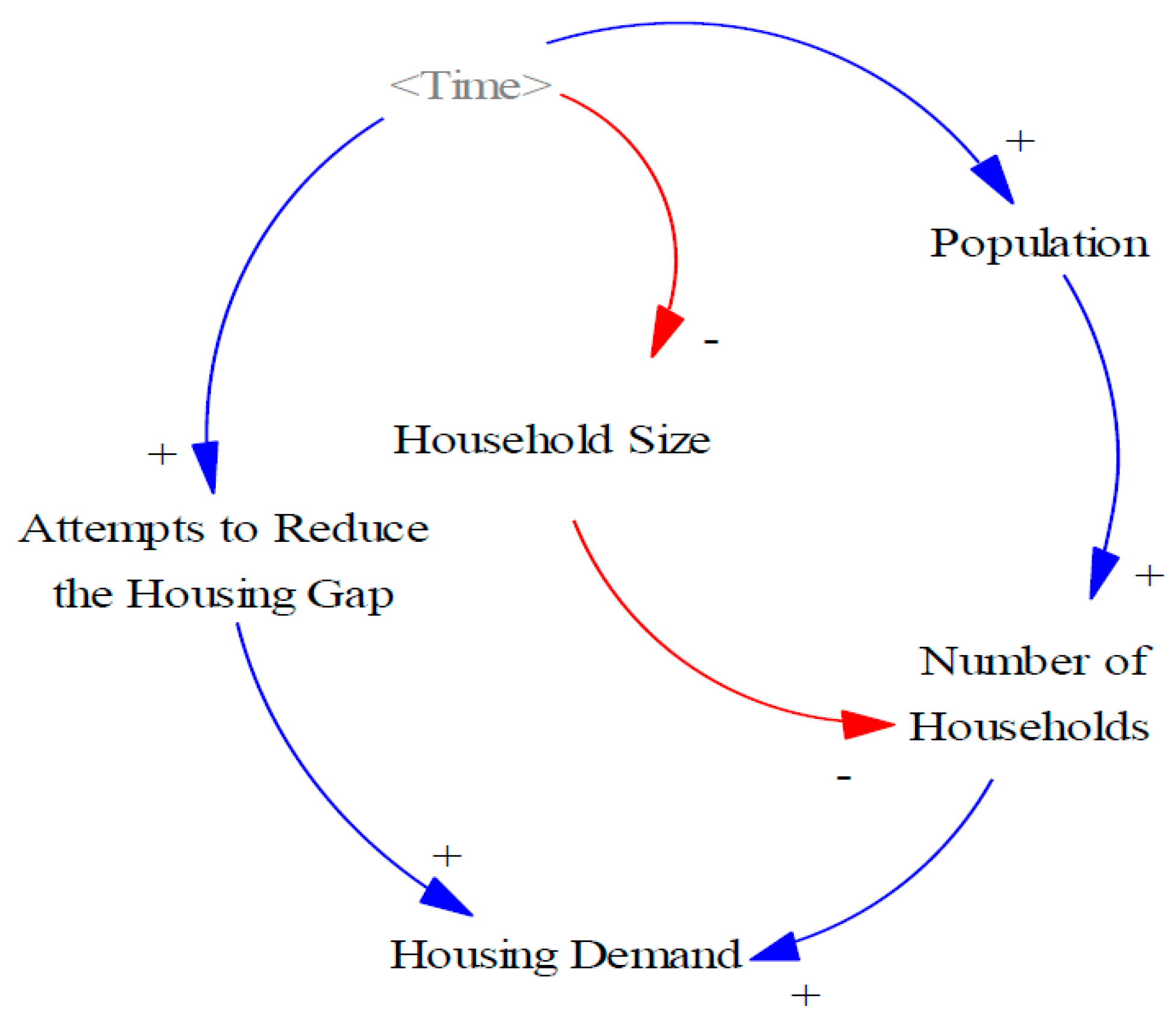
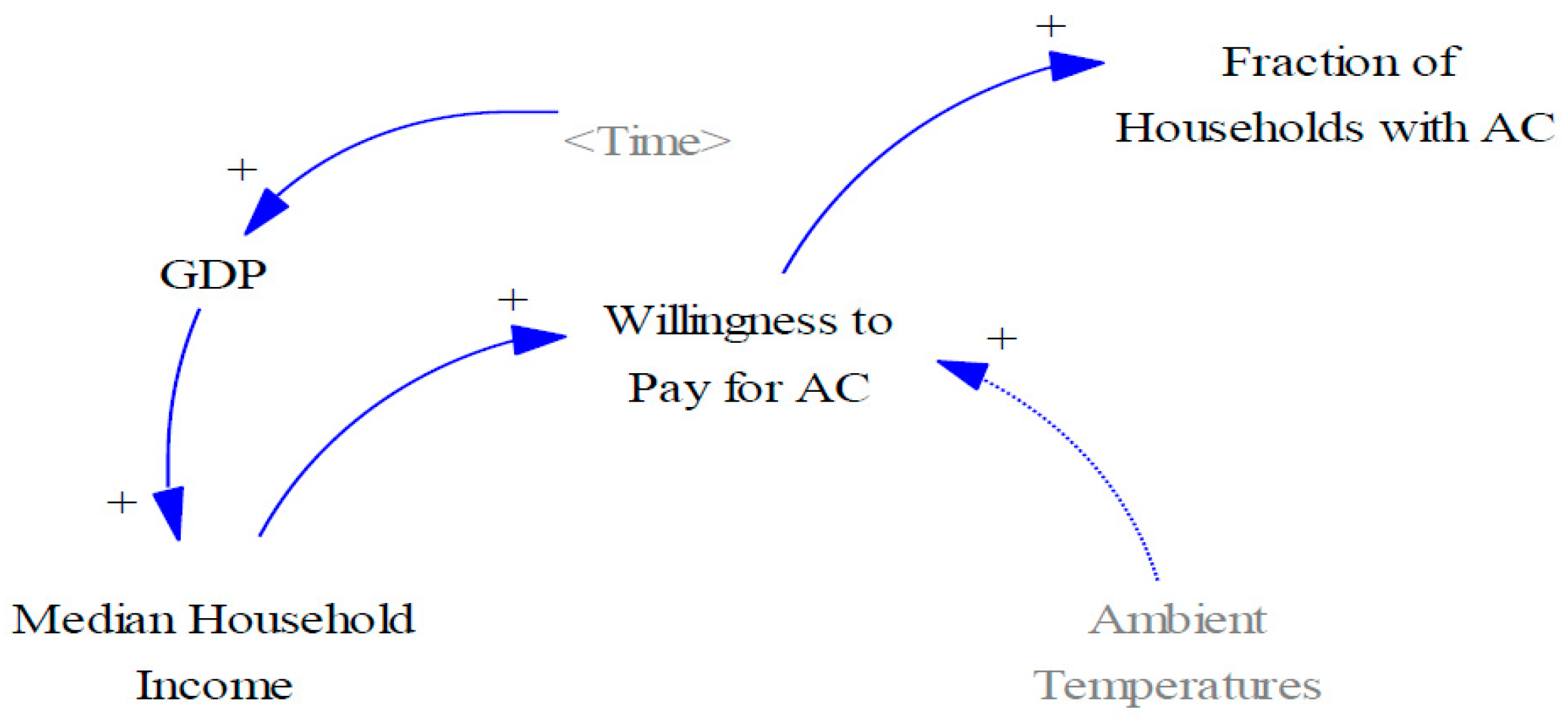
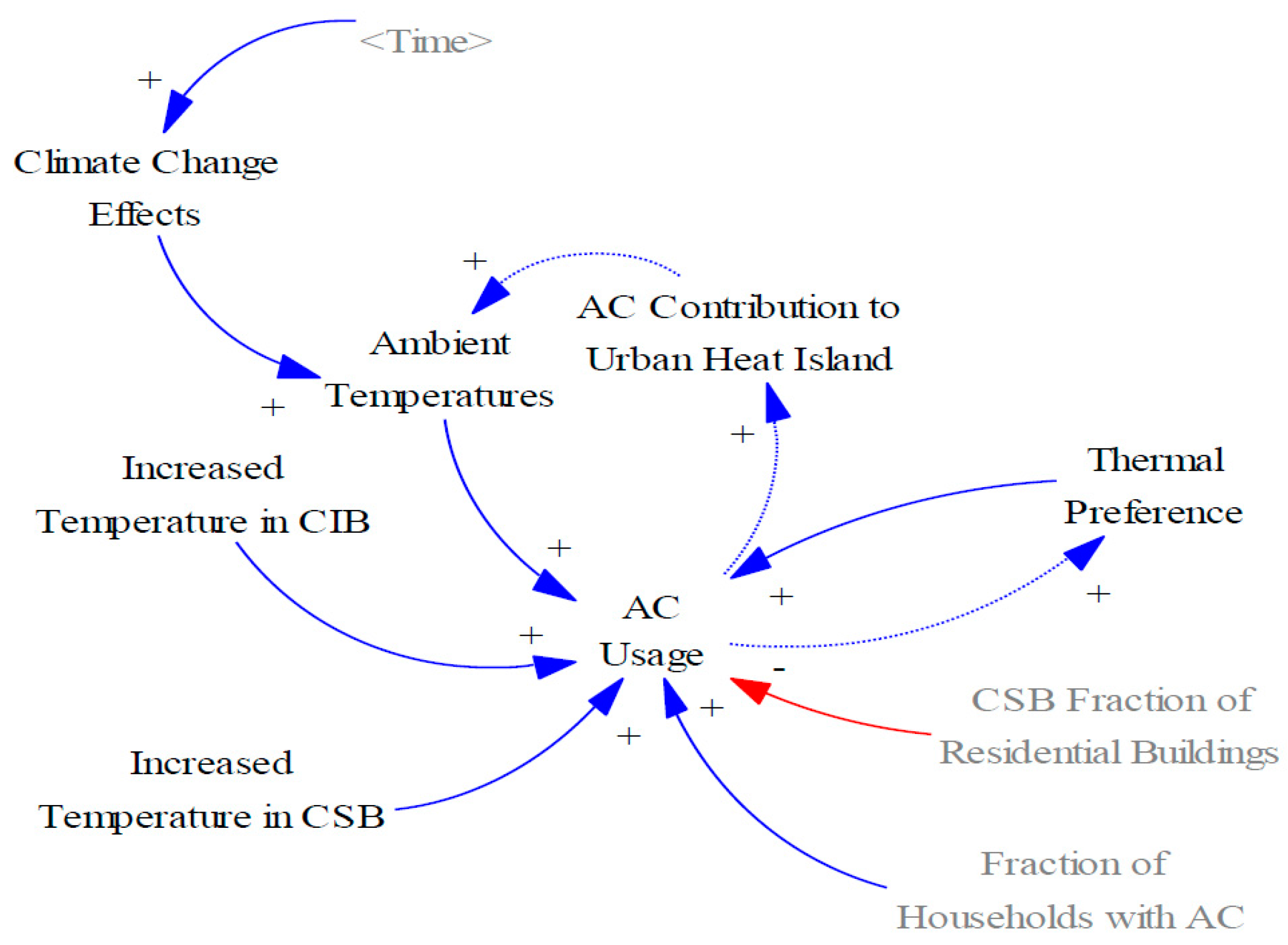
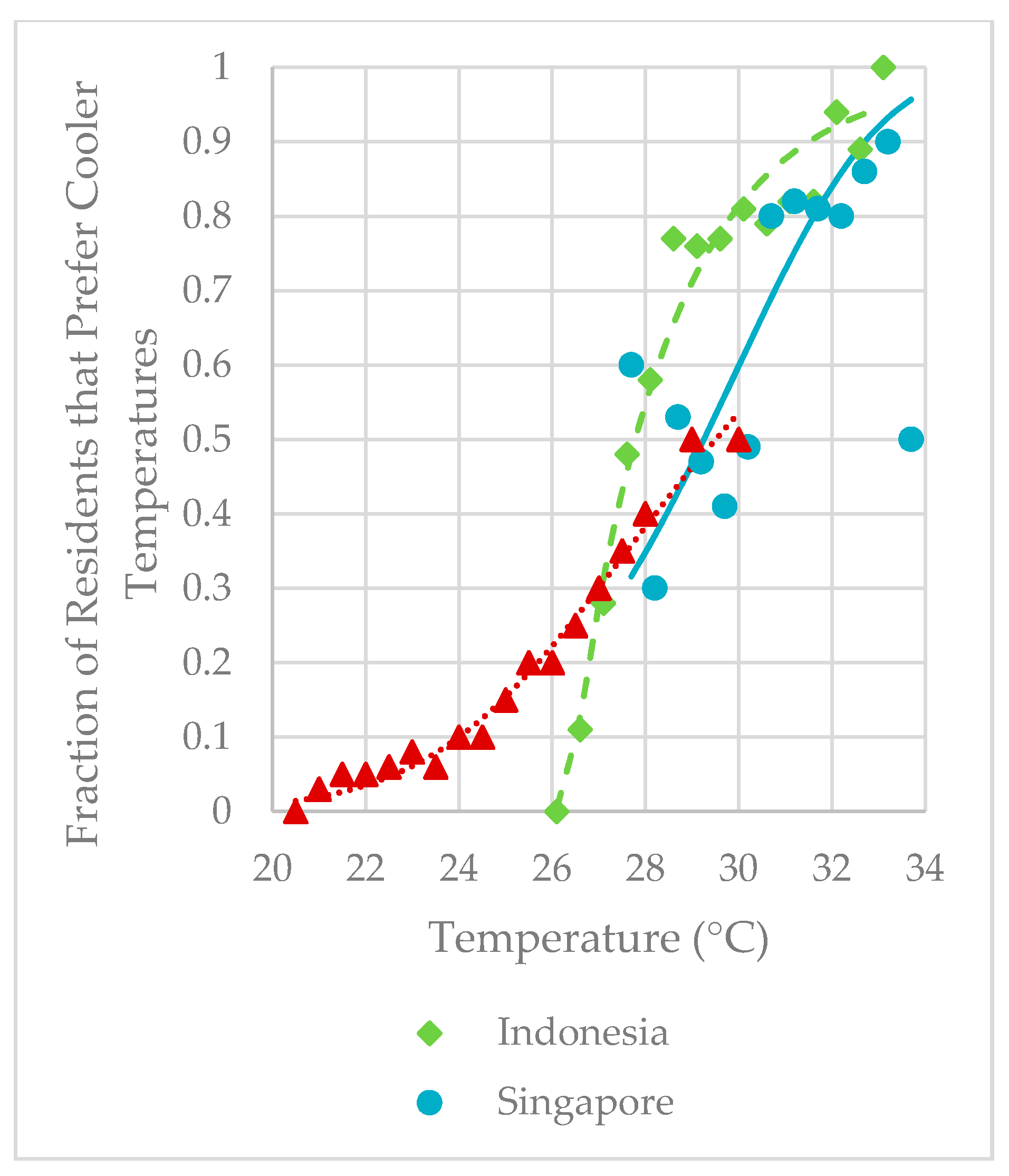
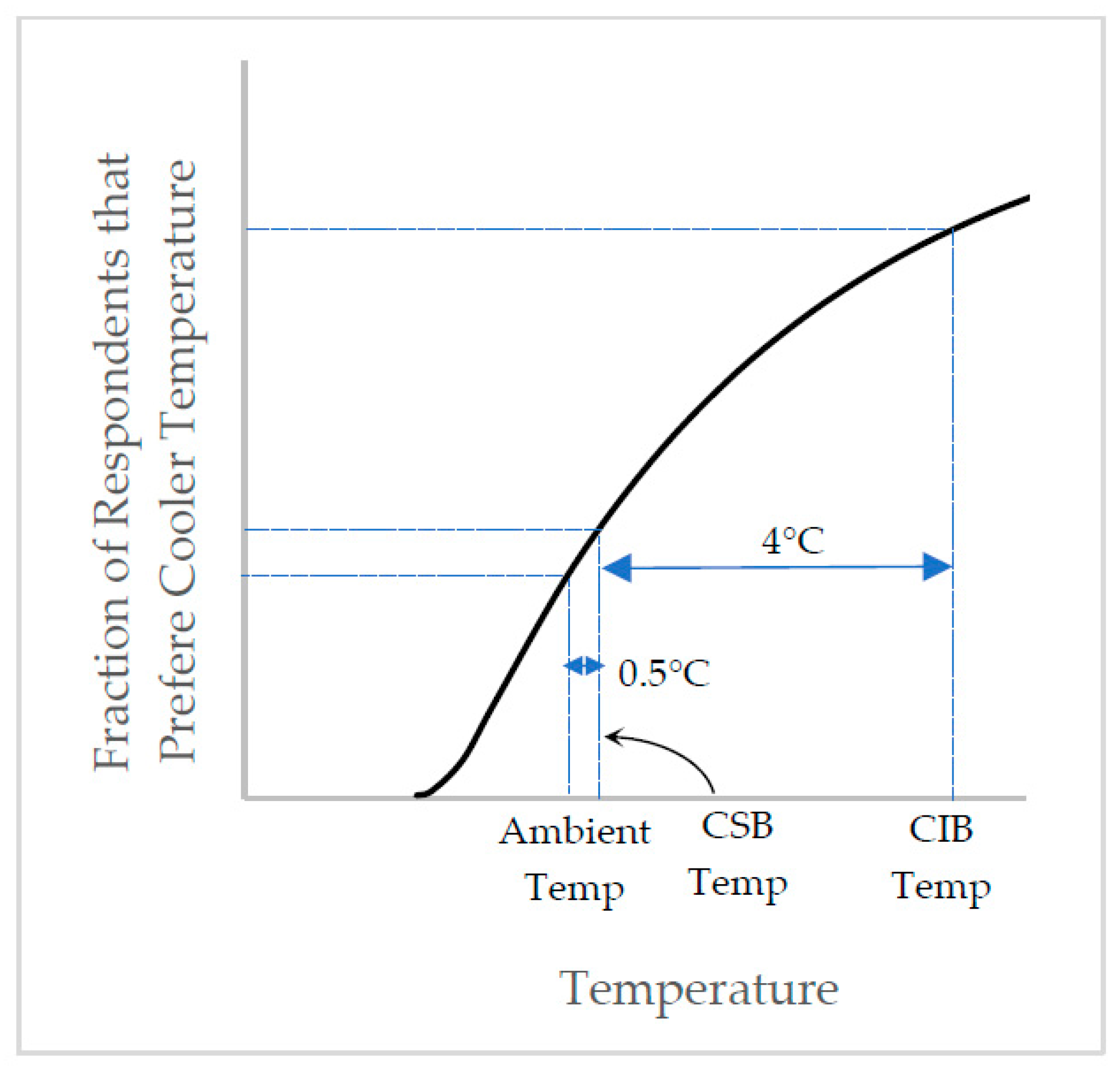
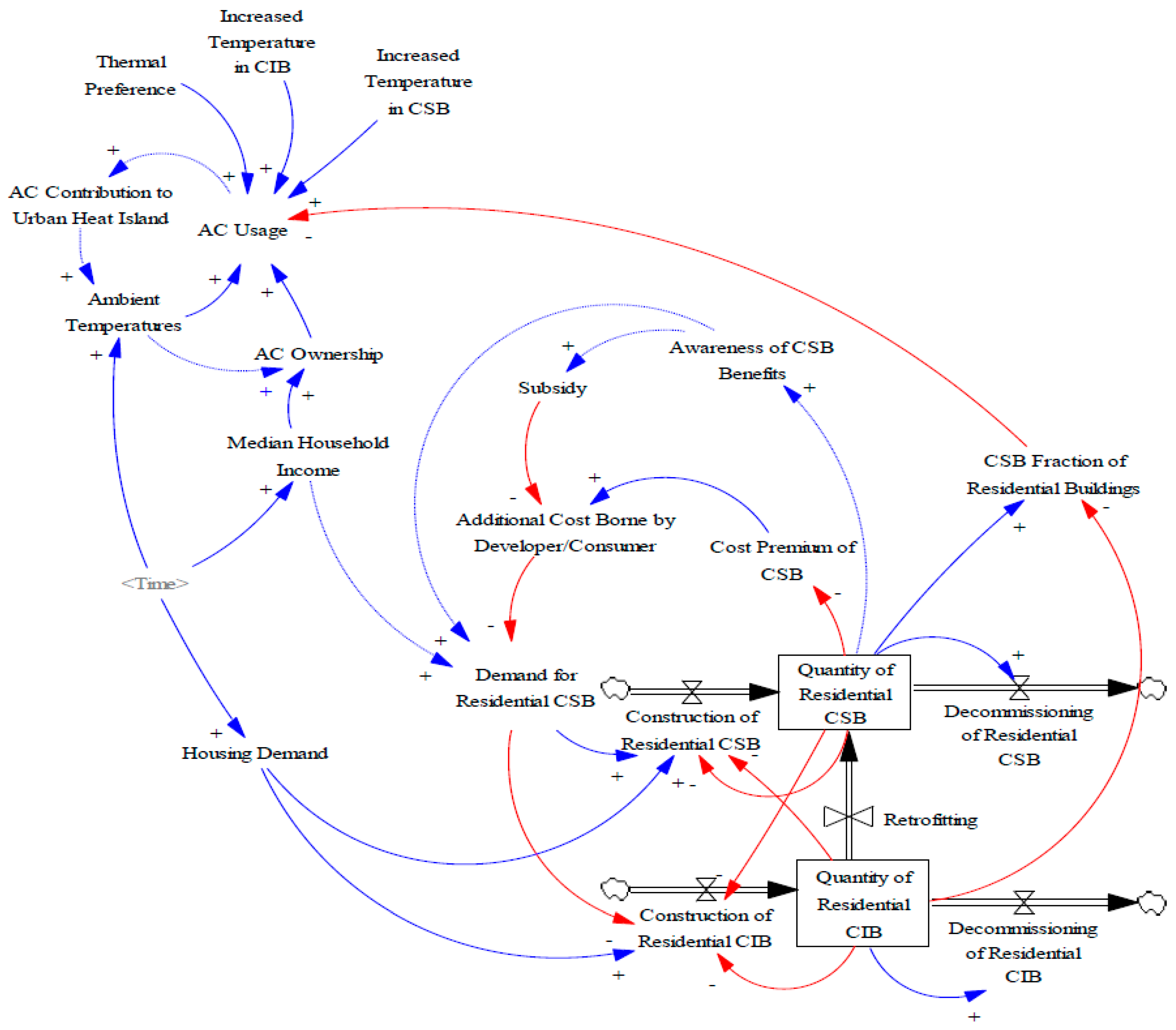
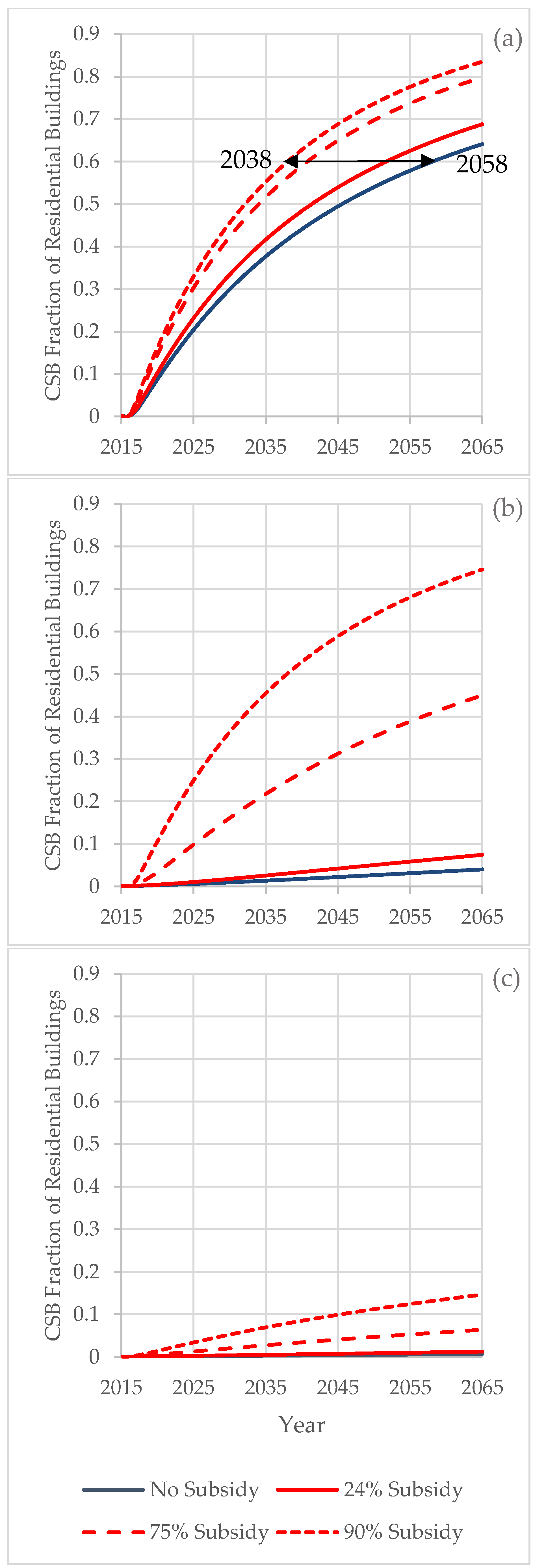
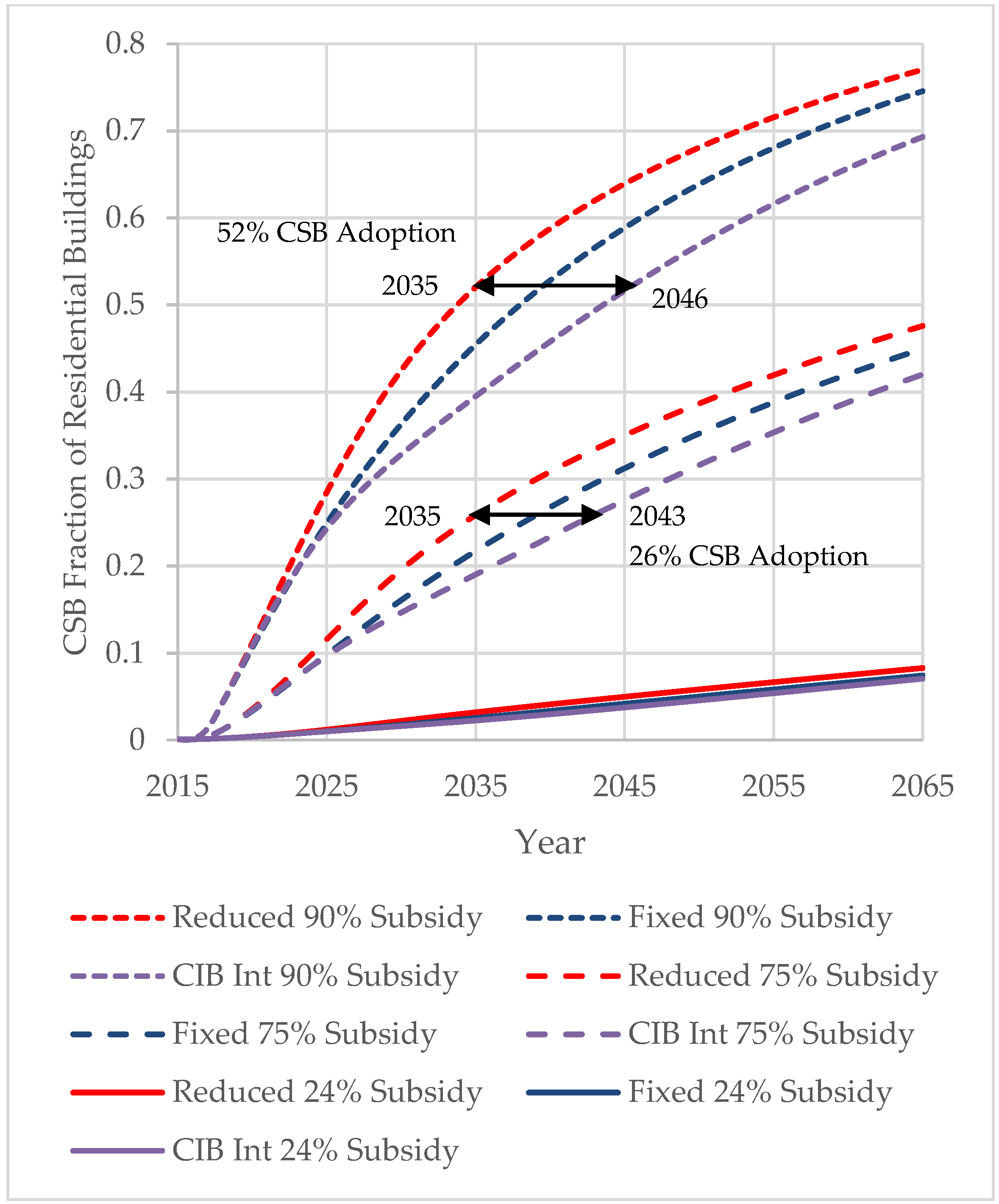
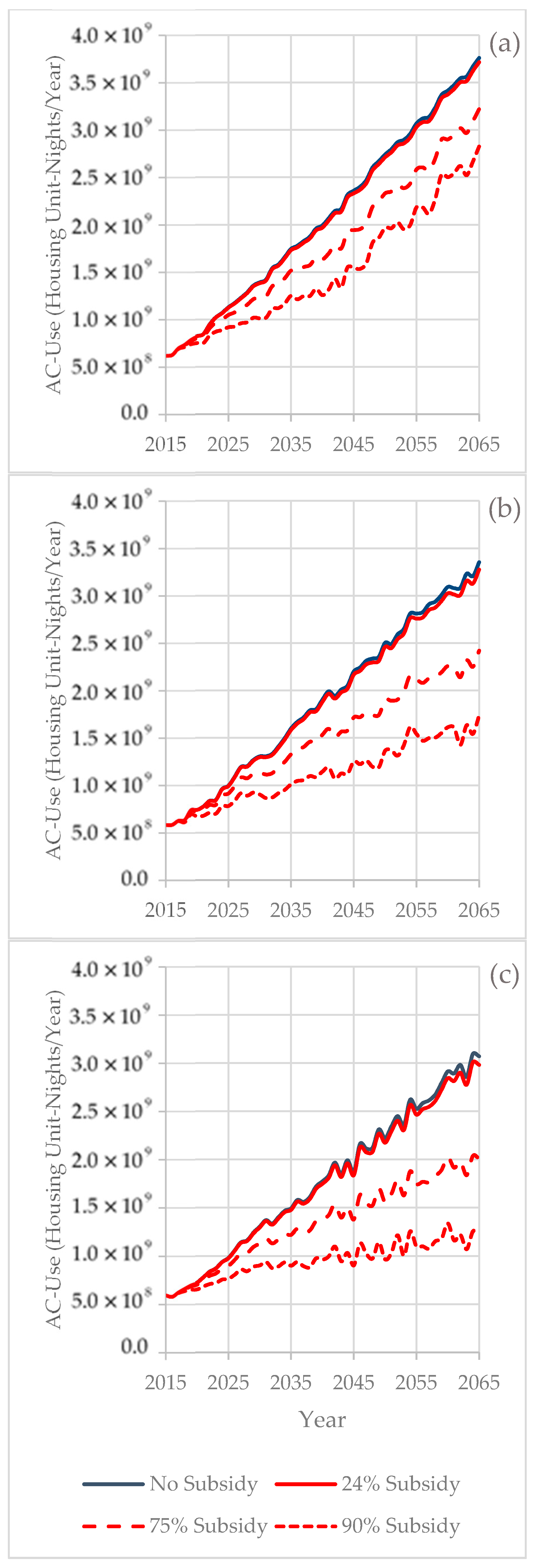
| Group | Variable | Variable Type and Notes |
|---|---|---|
| Cost-Premium Reinforcing Loop and Building Stocks (Section 2.2) | Additional Cost Borne by Developer/Consumer | Output variable. |
| Awareness of CSB Benefits | Conceptual link showing potentially important feedback pathway. | |
| Construction of Residential CIB | Output variable. | |
| Construction of Residential CSB | Output variable. | |
| Cost Premium of CSB | Output variable. Progress ratio, describing the rate of change, is an input variable (not easily extracted from the equation as a separate variable) and a sensitivity parameter. The initial value of the cost premium of CSB is an input variable and sensitivity parameter. | |
| CSB Fraction of Residential Buildings | Output variable | |
| Decommissioning of Residential CIB | Output variable. Decommissioning rate is built into this variable and is a sensitivity parameter. | |
| Decommissioning of Residential CSB | Output variable. | |
| Demand for Residential CSB | Output variable. | |
| Quantity of Residential CSB | Output variable. | |
| Quantity of Residential CIB | Output variable. | |
| Retrofitting | Conceptual link showing potential pathway for increasing residential CSB. | |
| Subsidy | Input variable and sensitivity parameter used in all scenarios. | |
| Willingness to Pay for CSB | Input variable and scenario parameter. Note that this is subsumed into Demand for Residential CSB in Figure 9 and in the simulation working model. | |
| Factors Driving Housing Demand in Malaysia (Section 2.3) | Attempts to Reduce the Housing Gap | Input variable and scenario parameter. Note that this is subsumed into Housing Demand in Figure 9 |
| Household Size | Input variable. Note that this is subsumed into Housing Demand in Figure 9 | |
| Housing Demand | Output variable. | |
| Number of Households | Output variable. Note that this is subsumed into Housing Demand in Figure 9 | |
| Population | Input variable. Note that this is subsumed into Housing Demand in Figure 9 | |
| Factors Driving Willingness to Pay for Air-Conditioning in Malaysia (Section 2.4) | AC Ownership | Output Variable. |
| GDP | Conceptual link to indicate reason for changes in Median Household Income. Note that this is subsumed into Median Household Income in Figure 9 and in the simulation working model. | |
| Median Household Income | Input variable and sensitivity parameter. | |
| Willingness to Pay for AC | Conceptual link between Median Household Income and AC Ownership. Note that this is subsumed into AC Ownership in Figure 9 and in the simulation working model. | |
| Factors Driving AC Usage in Malaysia (Section 2.5) | AC Contribution to Urban Heat Island | Conceptual link showing potentially important feedback pathway. |
| AC Usage | Output variable. | |
| Ambient Temperatures | Input variable and scenario parameter. | |
| Climate Change Effects | Conceptual link to indicate reason for ambient temperature changes. Note that this is subsumed into Ambient Temperatures in Figure 9 and in the simulation working model. | |
| Increased Temperature in CIB | Input variable. | |
| Increased Temperature in CSB | Input variable. | |
| Thermal Preference | Input variable and sensitivity analysis parameter. |
| Variable | Analysis Type | Description |
|---|---|---|
| Subsidy | Scenario and Sensitivity | Four subsidy levels: no subsidy, 24% subsidy, 75% subsidy and 90% subsidy were used to evaluate all scenarios and sensitivity analysis. |
| Willingness to Pay for CSB (Subsumed under Demand for CSB) | Scenario | CSB uptake under different subsidy levels and three different WTP curves: High, Medium and Low. |
| Attempts to Reduce the Housing Gap | Scenario | CSB uptake under different subsidy levels and three different approaches to reducing the housing gap: Fixed (static housing gap), Reduced (housing gap reduced without compromising CSB uptake) and CIB Int (housing gap intervention relying on cheaper climate insensitive buildings). |
| Ambient Temperature | Scenario | AC use under different subsidy levels and three different climate change scenarios: A1FI (large temperature increases), A1B (moderate temperature increases) and B1 (small temperature increase). |
| Cost Premium of CSB | Sensitivity | CSB uptake under different subsidy levels and progress ratios (rate at which cost premium of CSB decreases with experience). Progress ratio values of 0.75, 0.8 (baseline) and 0.9 used. |
| Sensitivity | CSB uptake under different subsidy levels and initial cost premium. Initial cost premium values of 2%, 5% (baseline) and 10% used. | |
| Decommissioning of Residential CIB | Sensitivity | CSB uptake under different subsidy levels and building decommissioning rates. Building lifespans of 50 years (baseline) and 100 years used. |
| Median Household Income | Sensitivity | AC use under different subsidy levels and four household income/GDP scenarios: median household income growth at 70% of GDP, 80% of GDP (baseline) and 90% of GDP, as well as median household income under low GDP growth. |
| Thermal Preference | Sensitivity | AC use under different subsidy levels and two thermal preference curves: Indonesia (baseline) and Singapore. |
| Climate Chance Scenario | Subsidy Level and Residential CSB Adoption Rate | 2065 AC Usage Relative to No Subsidy Case | 2065 AC Usage Relative to 2015 |
|---|---|---|---|
| A1FI (High) | No subsidy, 3.9% | 1.0 | 6.1 |
| 24% subsidy, 7.4% | 0.99 | 6.0 | |
| 75% subsidy, 45% | 0.86 | 5.2 | |
| 90% subsidy, 74% | 0.75 | 4.6 | |
| A1B (Medium) | No subsidy, 3.9% | 1.0 | 5.7 |
| 24% subsidy, 7.4% | 0.98 | 5.6 | |
| 75% subsidy, 45% | 0.72 | 4.1 | |
| 90% subsidy, 74% | 0.52 | 3.0 | |
| B1 (Low) | No subsidy, 3.9% | 1.0 | 5.2 |
| 24% subsidy, 7.4% | 0.97 | 5.0 | |
| 75% subsidy, 45% | 0.65 | 3.4 | |
| 90% subsidy, 74% | 0.40 | 2.1 |
© 2017 by the authors. Licensee MDPI, Basel, Switzerland. This article is an open access article distributed under the terms and conditions of the Creative Commons Attribution (CC BY) license (http://creativecommons.org/licenses/by/4.0/).
Share and Cite
Tan, D.T.; Gong, Y.; Siri, J.G. The Impact of Subsidies on the Prevalence of Climate-Sensitive Residential Buildings in Malaysia. Sustainability 2017, 9, 2300. https://doi.org/10.3390/su9122300
Tan DT, Gong Y, Siri JG. The Impact of Subsidies on the Prevalence of Climate-Sensitive Residential Buildings in Malaysia. Sustainability. 2017; 9(12):2300. https://doi.org/10.3390/su9122300
Chicago/Turabian StyleTan, David T., Yi Gong, and José Gabriel Siri. 2017. "The Impact of Subsidies on the Prevalence of Climate-Sensitive Residential Buildings in Malaysia" Sustainability 9, no. 12: 2300. https://doi.org/10.3390/su9122300
APA StyleTan, D. T., Gong, Y., & Siri, J. G. (2017). The Impact of Subsidies on the Prevalence of Climate-Sensitive Residential Buildings in Malaysia. Sustainability, 9(12), 2300. https://doi.org/10.3390/su9122300





